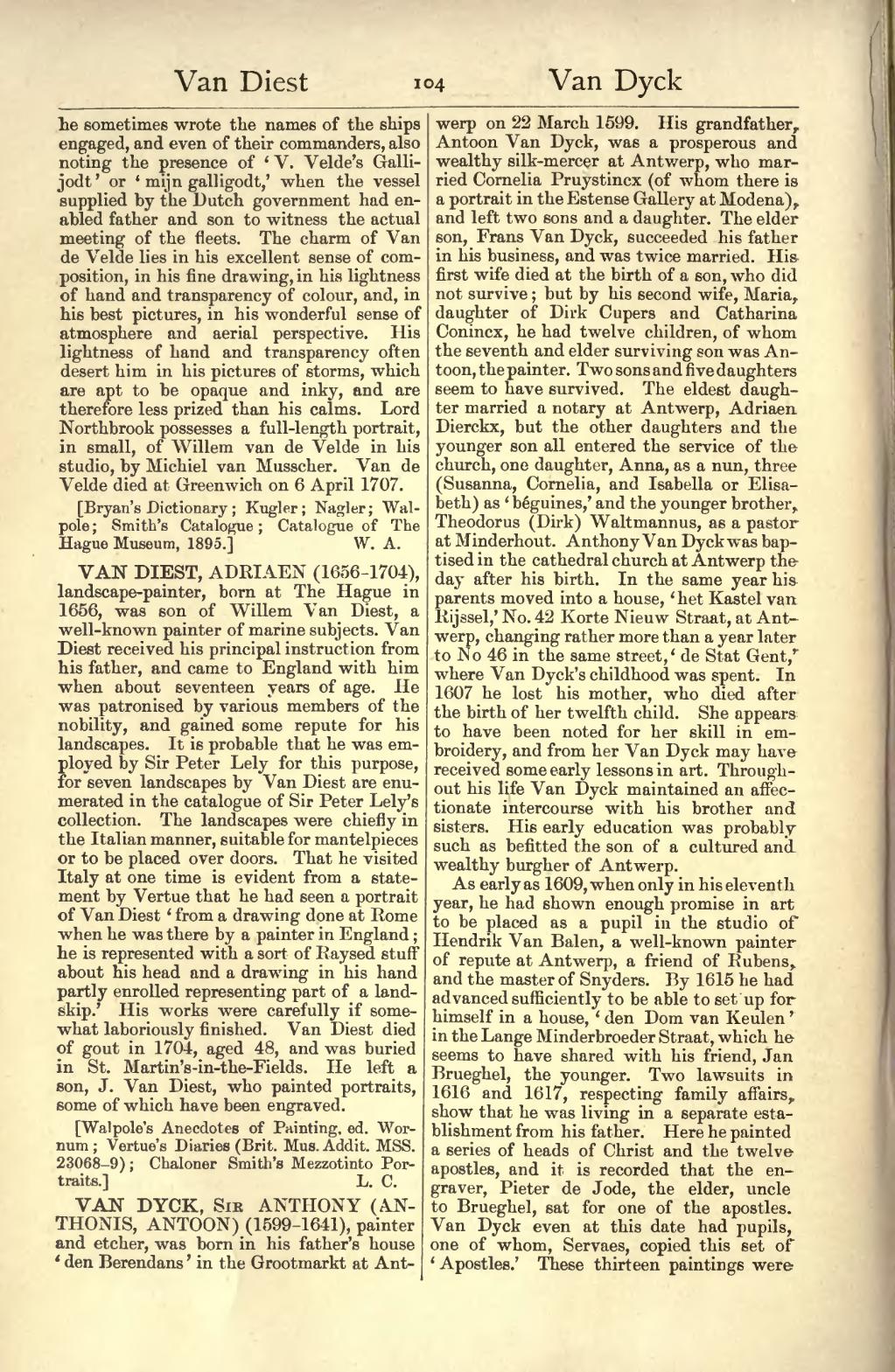he sometimes wrote the names of the ships engaged, and even of their commanders, also noting the presence of ‘V. Velde's Gallijodt’ or ‘mijn galligodt,’ when the vessel supplied by the Dutch government had enabled father and son to witness the actual meeting of the fleets. The charm of Van de Velde lies in his excellent sense of composition, in his fine drawing, in his lightness of hand and transparency of colour, and, in his best pictures, in his wonderful sense of atmosphere and aerial perspective. His lightness of hand and transparency often desert him in his pictures of storms, which are apt to be opaque and inky, and are therefore less prized than his calms. Lord Northbrook possesses a full-length portrait, in small, of Willem van de Velde in his studio, by Michiel van Musscher. Van de Velde died at Greenwich on 6 April 1707.
[Bryan's Dictionary; Kugler; Nagler; Walpole; Smith's Catalogue; Catalogue of The Hague Museum, 1895.]
VAN DIEST, ADRIAEN (1656–1704), landscape-painter, born at The Hague in 1656, was son of Willem Van Diest, a well-known painter of marine subjects. Van Diest received his principal instruction from his father, and came to England with him when about seventeen years of age. He was patronised by various members of the nobility, and gained some repute for his landscapes. It is probable that he was employed by Sir Peter Lely for this purpose, for seven landscapes by Van Diest are enumerated in the catalogue of Sir Peter Lely's collection. The landscapes were chiefly in the Italian manner, suitable for mantelpieces or to be placed over doors. That he visited Italy at one time is evident from a statement by Vertue that he had seen a portrait, of Van Diest ‘from a drawing done at Rome when he was there by a painter in England; he is represented with a sort of Raysed stuff about his head and a drawing in his hand partly enrolled representing part of a landskip.’ His works were carefully if somewhat laboriously finished. Van Diest died of gout in 1704, aged 48, and was buried in St. Martin's-in-the-Fields. He left a son, J. Van Diest, who painted portraits, some of which have been engraved.
[Walpole's Anecdotes of Painting, ed. Wornum; Vertue's Diaries (Brit. Mus. Addit. MSS. 23068–9); Chaloner Smith's Mezzotinto Portraits.]
VAN DYCK, Sir ANTHONY (ANTHONIS, ANTOON) (1599–1641), painter and etcher, was born in his father's house ‘den Berendans’ in the Grootmarkt at Antwerp on 22 March 1599. His grandfather, Antoon Van Dyck, was a prosperous and wealthy silk-mercer at Antwerp, who married Cornelia Pruystincx (of whom there is a portrait in the Estense Gallery at Modena), and left two sons and a daughter. The elder son, Frans Van Dyck, succeeded his father in his business, and was twice married. His first wife died at the birth of a son, who did not survive; but by his second wife, Maria, daughter of Dirk Cupers and Catharina Conincx, he had twelve children, of whom the seventh and elder surviving son was Antoon, the painter. Two sons and five daughters seem to have survived. The eldest daughter married a notary at Antwerp, Adriaen Dierckx, but the other daughters and the younger son all entered the service of the church, one daughter, Anna, as a nun, three (Susanna, Cornelia, and Isabella or Elisabeth) as ‘béguines,’ and the younger brother, Theodorus (Dirk) Waltmannus, as a pastor at Minderhout. Anthony Van Dyck was baptised in the cathedral church at Antwerp the day after his birth. In the same year his parents moved into a house, ‘het Kastel van Rijssel,’ No. 42 Korte Nieuw Straat, at Antwerp, changing rather more than a year later to No 46 in the same street, ‘de Stat Gent,’ where Van Dyck's childhood was spent. In 1607 he lost his mother, who died after the birth of her twelfth child. She appears to have been noted for her skill in embroidery, and from her Van Dyck may have received some early lessons in art. Throughout his life Van Dyck maintained an affectionate intercourse with his brother and sisters. His early education was probably such as befitted the son of a cultured and wealthy burgher of Antwerp.
As early as 1609, when only in his eleventh year, he had shown enough promise in art to be placed as a pupil in the studio of Hendrik Van Balen, a well-known painter of repute at Antwerp, a friend of Rubens, and the master of Snyders. By 1615 he had advanced sufficiently to be able to set up for himself in a house, ‘den Dom van Keulen’ in the Lange Minderbroeder Straat, which he seems to have shared with his friend, Jan Brueghel, the younger. Two lawsuits in 1616 and 1617, respecting family affairs, show that he was living in a separate establishment from his father. Here he painted a series of heads of Christ and the twelve apostles, and it is recorded that the engraver, Pieter de Jode, the elder, uncle to Brueghel, sat for one of the apostles. Van Dyck even at this date had pupils, one of whom, Servaes, copied this set of ‘Apostles.’ These thirteen paintings were
